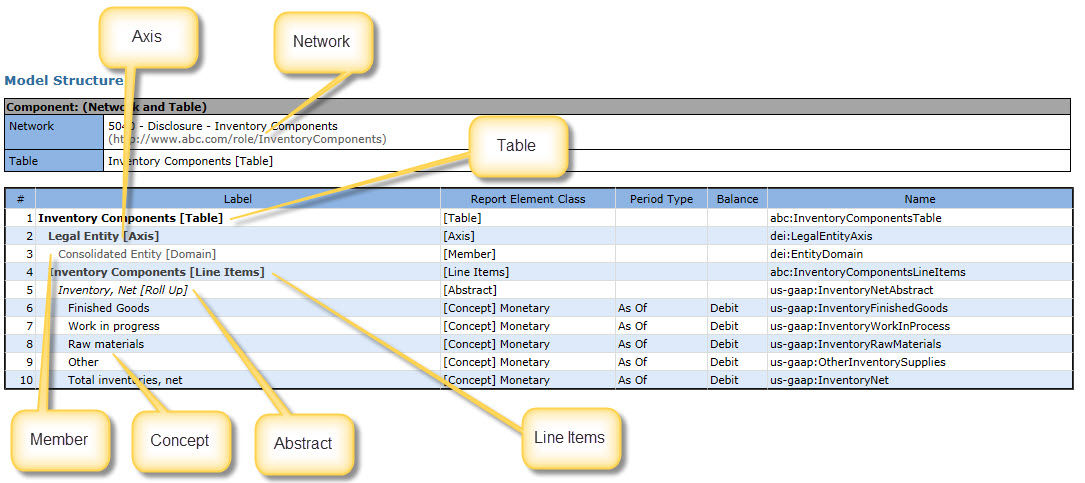
This work is licensed under a Creative Commons License.
An SEC XBRL financial filing is comprised of report elements. Those report elements can be categorized into groups: Network, Table, Axis, Member, LineItems, Abstract, and Concept. These terms are defined here. These different cagegories of report elements can be related to other categories of report elements. This is the results of an analysis of the relations between report elements for 5262 SEC XBRL financial filings. Most of these relations are logical, rational, and make sense. A minority of the relations make little or no sense or are ambiguous.
SUMMARY OF RESULTS
This is an analysis of parent report elements and what the immediate children of that parent are. For example,
looking at the first set; the parent report element category of "Network" has 0 children which are of the category Network,
676 children of the category Table, 3 of the category Axis, 2 of the category Member, 167 of the category LineItems,
41 of the category Concept, and 348,674 of the category Abstract.
Parents (Networks): 355,903
Networks : 0
Table : 676 {Less than .2% of all Networks have a [Table] as a child
Axis : 3 {A Network would NEVER have an [Axis] as an immediate child
Member : 2 {A Network would NEVER have an [Member] as an immediate child
LineItems: 167 {A Network would NEVER have an [Line Items] as an immediate child
Concept : 41 {Having a Concept as a child of a Network is not really a good practice, but is not ambiguous
Abstract : 348,674 {98% of all Networks have an [Abstract] as a child, SEC requires this but rule not followed by (676 + 3 + 2 + 167 + 41 = 889) filers
Parents (Table): 172,977
Network : 0
Table : 1 {A [Table] would never have another [Table] as a child
Axis : 271,698 {Yes, [Table]s have [Axis] as children
Member : 0 {Yes, [Table]s should never have a [Member] as a child
LineItems: 172,933 {Yes, [Table]s have [Line Items] as a child, exactly 1; seems like there are 44 that don't
Concept : 25 {ERROR, a Concept would NEVER be the child of a [Table]
Abstract : 10 {ERROR, an [Abstract] would NEVER be the child of a [Table]
Parents (Axis): 271,721
Network : 0
Table : 0
Axis : 0
Member : 325,159 {Yes, [Member]s can be a child of an [Axis]
LineItems: 0
Concept : 10 {ERROR, a Concept would NEVER be the child of an [Axis]
Abstract : 0
Parents (Member): 806,507
Network : 0
Table : 0
Axis : 0
Member : 481,260 {Yes, [Member]s can have [Member]s as children
LineItems: 0
Concept : 115 {ERROR, a Concept would NEVER be the child of an [Member]
Abstract : 1 {ERROR, an [Abstract] would NEVER be the child of an [Member]
Parent (LineItems): 173,345
Network : 0
Table : 34 {ERROR, a [Table] would never be the child of another [LineItems]; what would that mean?
Axis : 3 {ERROR, an [Axis] would never be the child of another [LineItems]; what would that mean?
Member : 3 {ERROR, a [Member] would never be the child [LineItems]; what would that mean?
LineItems: 75 {ERROR, a [LineItems] would never be the child of another [LineItems]; what would that mean?
Concept : 885,943 {Yes, [LineItems] contain Concepts
Abstract : 83,036 {Yes, [LineItems] contain [Abstract]s
Parents (Concept): 2,287,955
Network : 0
Table : 19 {This is rare and it probably will not hurt anything, but Concepts generally don't have [Table]s as children
Axis : 0
Member : 1 {ERROR, Concepts don't ever have [Member]s as children
LineItems: 2 {ERROR, Concepts don't ever have [LineItems] as children
Concept : 11,253 {Yes, Concepts can be children of other Concepts
Abstract : 489 {Yes, [Abstract]s can be children of Concepts; but this sort of does not make a lot of sense
Parents (Abstract): 540337
Network : 0
Table : 172,247 {Yes, [Abstract]s can have a [Table] as a child
Axis : 17 {ERROR, an [Abstract] should never have an [Axis] as a child
Member : 82 {ERROR, an [Abstract] should never have a [Member] as a child
LineItems: 168 {ERROR, an [Abstract] should never have a [LineItems] as a child; [LineItems] are children of [Table]s
Concept : 1,390,568 {Yes, [Abstract]s can have a Concept as a child
Abstract : 108,127 {Yes, [Abstract]s can have another [Abstract] as a child


This work is licensed under a Creative Commons License.